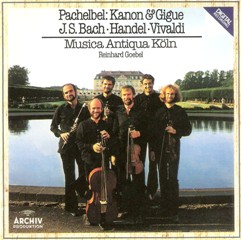111 Years of Deutsche Grammophon - CD 21
111 Years of Deutsche Grammophon - CD 21
Pachelbel: Canon & Gigue / Handel: Sonata, Op.5 / Vivaldi: Sonata, Op.1 "La Follia" / Bach, J.S.: Ochestral Suite, No.2

Johann Pachelbel (1653 - 1706) 1 Canon and Gigue in D major [4:41] George Frideric Handel (1685 - 1759) Trio Sonata for 2 Violins and Continuo in G, Op.5, No.4, HWV 399 2 1. Allegro [2:02] 3 2. A tempo ordinario - Allegro non presto – Adagio [4:14] 4 3. Passacaille [4:39] 5 4. Gigue (Presto) [1:05] 6 5. Menuet (Allegro moderato) [0:59] Antonio Vivaldi (1678 - 1741) 7 Trio Sonata in D minor for 2 Violins and Continuo, Op.1/12 , RV 63 "La Follia" [8:43] Johann Sebastian Bach (1685 - 1750) Suite No.2 in B minor, BWV 1067 8 1. Ouverture [10:08] 9 2. Rondeau [1:53] 10 3. Sarabande [3:14] 11 4. Bourrée I-II [1:33] 12 5. Polonaise [2:49] 13 6. Menuet [1:05] 14 7. Badinerie [1:18] Musica Antiqua Köln Reinhard Goebel – conductor
Pachelbel's Canon is the most famous piece of music by German Baroque composer Johann Pachelbel. It was originally scored for three violins and basso continuo and paired with a gigue in the same key. Like most other works by Pachelbel and other pre-1700 composers, the Canon remained forgotten for centuries and was rediscovered only in the 20th century. Several decades after it was first published in 1919, the piece became extremely popular, and today it is frequently played at weddings and included on classical music compilations, along with other famous Baroque pieces such as Air on the G String by Johann Sebastian Bach.
The trio sonata is a musical form that was popular in the 17th and early 18th centuries. A trio sonata is written for two solo melodic instruments and basso continuo, making three parts in all, hence the name trio sonata. The melody instruments used are often both violins. A well-known example are trio sonatas opp. 2 and 5 by Handel and Trio Sonata by Vivaldi.
In is unknown when exactly Johann Sebastian Bach wrote his Suite for Orchestra No. 2 in B minor, BWV 1067. It is a vibrant and fast-paced work, leaning towards the entertainment side of pure music. This suite is one of four such works that the composer wrote in his lifetime. Bach was not even slightly opposed to writing music for more money or power, but was less forthcoming with light music; he did not like it much. All of the lighter music he wrote was never published, including these overtures.








